Aluminium Design and Construction - Chapter 4 pptx
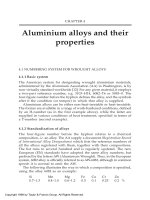
Aluminium Design and Construction - Chapter 4 pptx
... Heat-treated forgings can be obtained in alloys such as 6082 and 20 14, with properties in the T4 and T6 conditions comparable to those for other wrought products in those alloys. 4. 4 STRESS-STRAIN ... more rounded knee. One can thus refer to ‘high-n’ and ‘low- n’ materials. n typically ranges from 40 down to 5 for aluminium materials. 4. 4.2 Stress-strain curve for minimum streng...
Ngày tải lên: 22/07/2014, 18:22

Aluminium Design and Construction - Chapter 6 pptx
... non-heat-treatable material there is negligible dip at A, and k z3 =k z1 . 6 .4. 2 Heat-treated material Table 6.1 lists proposed k z -values for MIG-welded joints in 6xxx and 7xxx-series alloys. These have generally ... tool. 4. The softened area will tend to be rather less than that obtained with MIG. Note, however, that it is possible to FS-weld together extruded sections in the T4-...
Ngày tải lên: 22/07/2014, 18:22
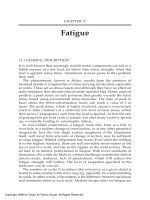
Aluminium Design and Construction - Chapter 12 ppt
... cut-off. For any given class, the equations to lines A and B are as follows, where the values of kA and k B appear in Table 12.5: (12.4a) (12.4b) Also given in the table are the cut-off ... Hydro -Aluminium in Norway on transverse butt welds in 6082-T4 extruded material, 5 mm thick, suggest that class 50 might be appropriate for such a joint. This compares with class 24 for a sin...
Ngày tải lên: 22/07/2014, 18:22

Aluminium Design and Construction - Chapter 11 docx
... 25°C. 3. Columns 3 and 4 give the room temperature curing time to achieve =1 and =10 N/mm 2 , when tested at 23°C. 4. Columns 5 and 6 give typical average strengths when tested at 23°C and 80°C, after ... parent metal, and k z1 = softening factor (Section 6 .4. 1). For the non-heat-treatable alloys it is found from: p f =0.5(f oo +f uo ) (11.18b) where f oo and f uo are the p...
Ngày tải lên: 22/07/2014, 18:22
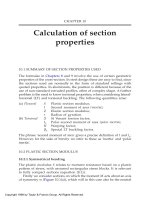
Aluminium Design and Construction - Chapter 10 pps
... right up to the circle or square: Circle =0.10d 4 Square =0.14a 4 (10.20) where d is the circle diameter, and a the side of the square. 10 .4. 4 Polar inertia The polar inertia I p is defined ... are bisymmetric, radial-symmetric or skew-symmetric S coincides with G and g=0. For sections entirely composed of radiating outstand elements, such as angles and tees (‘type-R’ sections,...
Ngày tải lên: 22/07/2014, 18:22
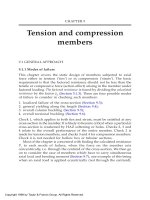
Aluminium Design and Construction - Chapter 9 docx
... block-width (b e1 or b e0 ) is explained in Sections 7.2.3 and 7.2 .4, or in Section 7 .4. 7 for reinforced elements. Very slender outstands need special consideration (Section 9.5 .4) . 9.2 .4 Allowance ... rotational restraint that the outstands may receive from the fillet material at the root. Double-angle (back-to-back) struts can also be regarded as effectively type-R. 9.6 .4 Sectio...
Ngày tải lên: 22/07/2014, 18:22
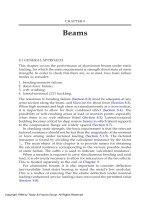
Aluminium Design and Construction - Chapter 8 doc
... times the usual value, where (equation (5 .4) ): (8 .40 ) The section is re-classified using this value, and if it is now found to be non-slender E may be re-calculated using I for the gross section. ... non-slender section, non-welded and without holes, the modulus S or Z is based on the actual gross cross-section. Otherwise, it should be found using the effective section (Section...
Ngày tải lên: 22/07/2014, 18:22
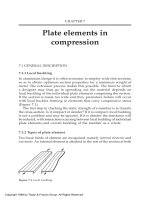
Aluminium Design and Construction - Chapter 7 pps
... values: Case T K=0 .41 for 1 > > 0.5 =0.50–0.18 for < 0.5 (7.14a) Case R K=0 .41 +1.3( 1- ) 4 (7.14b) Figure 7.12 Outstands under strain-gradient. Cases T and R. Copyright 1999 ... Reserved. Figure 7 .4 Slender internal element. Stress-pattern at failure, and assumed effective section. N=non-welded, W=with edge-welds. Figure 7.5 Slender outstand. Stress- pattern...
Ngày tải lên: 22/07/2014, 18:22
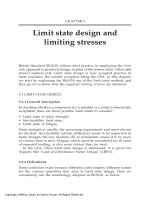
Aluminium Design and Construction - Chapter 5 pps
... grain). Table 5 .4 includes values for the stresses p p and p f needed in joint design, which also depend on the member properties. See Chapter 11. 5 .4 LIMITING STRESSES BASED ON BUCKLING 5 .4. 1 General ... appropriate scatter-band, with a cut-off at the limiting stress for the material. Local buckling of a thin-walled cross-section, as distinct from overall buckling of the member...
Ngày tải lên: 22/07/2014, 18:22
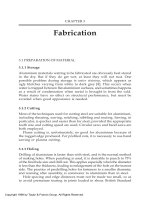
Aluminium Design and Construction - Chapter 3 potx
... appears in Chapter 4 (Section 4. 3 .4) . Because of aluminium s lower elastic modulus (E), springback is greater than with steel. Heat-treated material should only be manipulated when cold, and bending ... for non-aeronautical use are usually in the stronger kind of 6xxx-series alloy. They can be either machined from T6-condition bar-stock, or forged and then artificially aged (T8-c...
Ngày tải lên: 22/07/2014, 18:22